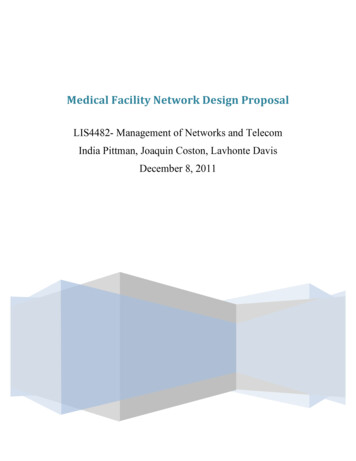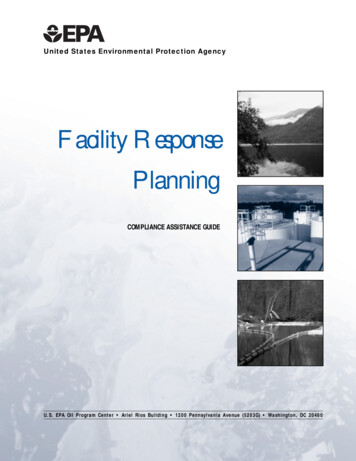
Transcription
United States Environmental Protection AgencyFacility ResponsePlanningCOMPLIANCE ASSISTANCE GUIDEU.S. EPA Oil Program Center Ariel Rios Building 1200 Pennsylvania Avenue (5203G) Washington, DC 20460
About the Compliance Assistance GuidesMany of the terms used in this guide haveFacility Response Planning2specifically defined in the regulation areThis guide is part of a series of compliance assistance guides that the U.S.Environmental Protection Agency (EPA) developed in order to help ownersand operators of facilities that store or use oil, as well as other interestedpeople, to better understand the Federal Oil Pollution Prevention regulation(40 CFR part 112). If you own or operate a facility that stores or uses oil,these guides will help you to determine whether the regulation applies toyou. They also provide descriptions of some of the basic requirements youwill be expected to meet if the regulation does apply to your facility.indicated by bold italic type when theyThe titles in this series include the following:first appear in the text of this guide. Introduction and Background to the Oil Pollution Prevention Regulationspecific definitions under the Oil PollutionPrevention Regulation. (Definitions can befound in 40 CFR 112.2.) Other regulator yprograms may define some of these termsdifferently. Words or phrases that are Who’s Who: Federal Agency Roles and Responsibilities for Oil SpillPrevention and Response What to Expect During an SPCC/FRP Inspection Facility Response Planning Sample SPCC Plan and Sample Containment Volume Calculations SPCC Requirements and Oil Pollution Prevention Practices for Bulk OilStorage Facilities SPCC Requirements and Oil Pollution Prevention Practices for OilProduction, Drilling, and Workover Facilities SPCC Requirements and Oil Pollution Prevention Practices for Farmsand Ranches SPCC Requirements and Oil Pollution Prevention Practices for Minesand Quarries SPCC Requirements and Oil Pollution Prevention Practices for VehicleService Facilities SPCC Requirements and Oil Pollution Prevention Practices for FacilitiesConducting Large Volume Transfer Operations SPCC Requirements and Oil Pollution Prevention Practices for Marinasand Other Waterside Fueling Facilities SPCC Requirements and Oil Pollution Prevention Practices for Airports SPCC Requirements and Oil Pollution Prevention Practices for RailroadFacilities SPCC Requirements and Oil Pollution Prevention Practices for ElectricalUtilities Oil Spill Notification, Response, and Recovery Industry Standards: A Guide for Owners and Operators of SPCCregulated Facilities
Keep in mind that this guide, and the others in this series, are intendedto provide guidance only. You should read the text of the Oil PollutionPrevention regulation carefully if you think it applies to you. It can befound at Title 40, Part 112 of the Code of Federal Regulations (40 CFR part112). The CFR is available at Federal Depository Libraries around thecountry, many of which are on the campuses of major colleges anduniversities. It is also available online at http://www.gpo.gov.You can obtain copies of any of the compliance assistance guides in thisseries by contacting EPA headquarters or any EPA Regional Office, or byvisiting EPA’s Oil Spill Program website at http://www.epa.gov/oilspill.Contact information for EPA Headquarters and Regional Offices isprovided at the end of this guide.What is the purpose of the Oil Pollution Preventionregulation?The regulation has two sets of requirements. The first set of requirements isthe Spill Prevention, Control, and Countermeasure (SPCC) rule. The SPCCrule is the basis of EPA’s oil spill prevention program. The second set ofrequirements is the Facility Response Plan (FRP) rule. The FRP program isdesigned to ensure that certain facilities have adequate oil spill responsecapabilities.3This guidance imposes no separateduties on facility owners or operators otherthan the requirements contained in theFRP rule. If there appears to be a conflictbetween what is stated in this guidanceand what is stated in the FRP rule (40 CFR112), the provisions of the FRP rule are theones to be followed. The statements in thisdocument are intended solely as guidance.What will I find in this guide?This document is not intended and cannotThis guide, Facility Response Planning, describes the preparation andsubmission of an FRP. Before reading this guide, you should read theIntroduction and Background to the Oil Pollution Prevention Regulation.be relied upon to create rights, substantiveEPA has prepared this guide to help you better understand the FRP rule. Itexplains what an FRP is, who must prepare one, and what the majorcomponents of a response plan are. It also provides a summary of the June2000 revisions made to the FRP rule. You must comply with theserequirements if you meet the applicability provisions set out in the rule.You can find the FRP rule in 40 CFR part 112, subpart D sections 112.20and 112.21. Information is also available on the EPA Oil Spill Programwebsite http://www.epa.gov/oilspill.SPCC Compliance Assistance Guideor procedural, enforceable by any party inlitigation with the United States.Facility Response PlanningWhen oil spills into navigable waters or onto adjoining shorelines, it canhave harmful impacts on the environment, human health, and economicactivity. EPA issued the Oil Pollution Prevention regulation to prevent oilspills and to assure that oil facility personnel are prepared to respond if aspill occurs.
What is a Facility Response Plan?Facility Response PlanningWhat types of oil does the ruleaddress?The term oil means oil of any kind or in anyform, including, but not limited to:petroleum; fuel oil; sludge; oil refuse; oilmixed with wastes other than dredgedspoil; fats, oils, or greases of animal, fish,or marine mammal origin; vegetable oils,According to the Clean Water Act (CWA), as amended by the Oil PollutionAct (OPA), certain facilities that store and use oil are required to prepareand submit plans to respond to a worst case discharge of oil and to asubstantial threat of such a discharge. EPA has established regulations thatdefine who must prepare and submit an FRP and what must be included inthe plan. An FRP is a plan for responding, to the maximum extentpracticable, to a worse case discharge, and to a substantial threat of such adischarge, of oil. The Plan also includes reponding to small and mediumdischarges as appropriate.including oils from seeds, nuts, fruits, orkernels; and other oils and greases,What are the requirements of EPA’sFacility Response Plan rule?including synthetic oils and mineral oils.4According to OPA, an owner or operator of a “substantial harm” facilitymust develop and implement an FRP. A “substantial harm” facility is afacility that, because of its location, could reasonably be expected to causesubstantial harm to the environment by discharging oil into or on navigablewaters or adjoining shorelines. EPA’s Facility Response Plan requirementswere published as a final rule in the Federal Register on July 1, 1994, andcodified at 40 CFR 112.20 and 112.21, including Appendices B through F.EPA published revisions to the rule in the Federal Register on June 30,2000, which modified the requirements for an owner or operator of afacility handling, storing, or transporting animal fat or vegetable oil toaccount for new research findings and to reflect new statutory requirementsunder the 1995 Edible Oil Regulatory Reform Act and EPA’s Fiscal Year1999 Appropriation.What is the purpose of a Facility Response Plan?The FRP helps an owner or operator develop a response organization andensure the availability of response resources (i.e., response equipment,trained personnel) needed to respond to an oil discharge. The FRP shouldalso demonstrate that the response resources are available in a timelymanner, thereby reducing a discharge’s impact and severity. The FRP alsohelps a facility owner or operator improve discharge prevention measuresthrough the early identification of risks at the facility. In addition, FRPs aidlocal and regional response authorities to better understand the potentialhazards and response capabilities in their area.
Do I have to prepare a Facility Response Plan?EPA revised the Oil Pollution Prevention regulation in 2002 and somerevisions may affect whether you have a substantial harm facility. In somecases your facility may not meet the storage capacity thresholds for thesubstantial harm criteria, and you may not need to prepare and maintain anFRP. In other cases, you must have an FRP, but you may be able to revisethe calculations for worst case discharge planning levels. According to the2002 rule, effective August 16, 2002, the regulation no longer applies to thefollowing:What are navigable waters ofthe United States?Navigable waters are not only waters onwhich a craft may be launched. They alsoinclude the following types of waters, theirtributaries, and adjacent wetlands:1) Waters with a past, present, or possiblefuture use in interstate or foreigncommerce, including waters subject tothe ebb and flow of the tide;wetlands;3) All other waters whose use,degradation, or destruction could affectinterstate or foreign commerce; these Completely buried tanks that are subject to Underground Storage Tanktechnical requirements in 40 CFR parts 280 and 281;may include intrastate lakes, rivers, Containers with a storage capacity of less than 55 gallons; andmudflats, sandflats, playa lakes, or Portions of certain facilities used exclusively for wastewater treatment.natural ponds;streams (including intermittent streams),4) Impoundments of waters that areHow do I know if my facility may be classified as asubstantial harm facility?defined as waters of the United States;andThe flowchart of criteria for substantial harm (see Figure 1) shows thequestions you must answer to determine if your facility can be classified asa substantial harm facility. The classification can be met in one of twoways: Your facility meets the substantial harm criteria outlined in 40 CFR112.20(f)(1); or An EPA Regional Administrator (RA) determines that your facilityposes substantial harm to the environment.SPCC Compliance Assistance Guide52) Interstate waters, including interstate5) Territorial sea.Navigable waters do not include wastewater treatment systems or prior convertedcropland.Facility Response PlanningYou should first determine if your facility must comply with the SPCC rule.The Introduction and Background to the Oil Pollution PreventionRegulation describes the applicability of the rule. If your nontransportation-related facility is SPCC-regulated, and an oil discharge fromyour facility could reasonably be expected to cause “substantial harm” tothe environment from a discharge to navigable waters of the U.S. or theadjoining shoreline, you must prepare an FRP and submit it to the EPAregion. The RA will then determine whether your facility is a “significantand substantial harm” facility, which would require the RA to review andapprove your FRP. If your facility does not meet the substantial harmcriteria discussed in the sections below, you must complete a certificationform and maintain it at the facility for review by EPA during facilityinspections.
What are the substantial harm criteria?Facility Response Planning6Over Water TransfersYou can determine whether your facility meets the over water transfer criterion by answering the followingquestion: Does your facility transfer oil over water to or from vessels, and does your facility have a totaloil storage capacity greater than or equal to 42,000 gallons?In order to answer the above question you must first know the following: Your facility’s total oil storage capacity can be determined by adding the capacities of all oil storagecontainers (e.g., drums, tanks, electrical equipment), including aboveground containers with a capacityof 55 gallons or more. A vessel means any type of water craft capable of being used as a means of transportation on water.If you answered “yes” to the above question, your facility is a substantial harm facility, and you mustprepare and submit an FRP to the Regional Administrator.If you answered “no” to the above question, you must consider whether your facility meets any of thecriteria for facilities with 1,000,000 gallons or more of oil storage capacity (please see the next section).Other FacilitiesYou can determine whether your facility meets the oil storage capacity criterion by answering thefollowing question: Does your facility have a total storage capacity greater than or equal to 1,000,000gallons of oil?If you answered “yes” to the above question, you need to further evaluate the following criteria: Lack of secondary containment Proximity to fish and wildlife and sensitive environments Proximity to public drinking water intakes Reportable discharge greater than, or equal to 10,000 gallons within the last five yearsIf you answered “no” to the above question, you do not have to prepare and submit an FRP except at thediscretion of the RA. Instead, you are required to prepare a certification that your facility is not asubstantial harm facility (40 CFR part 112, Appendix C, Attachment C-II) and maintain this at your facilityalong with your SPCC plan.Secondary ContainmentYou can determine whether your facility meets the secondary containment criterion by answering thefollowing question: Do you lack secondary containment at your facility large enough to hold the capacityof the largest aboveground storage tank within each storage area plus sufficient freeboard to allow forprecipitation?If you answered “yes” to the above question, your facility is a substantial harm facility, and you do have toprepare and submit an FRP.
Flowchart of Criteria for Substantial HarmDoes the facility transfer oil overwater to or from vessels anddoes the facility have a total oilstorage capacity greater than orequal to 42,000 gallons?YesNoDoes the facility have a total oilstorage capacity greater than orequal to 1 million gallons?YesSubmit Response PlanWithin any aboveground storagetank area, does the facility lacksecondary containment that issufficiently large to contain the Yescapacity of the largestaboveground oil storage tankplus sufficient freeboard to allowfor precipitation?NoYesNoIs the facility located at adistance1 such that a dischargefrom the facility would shutdown a public drinking waterintake3?7YesNoHas the facility experienced areportable oil spill in an amountgreater than or equal to 10,000gallons within the last 5 years?YesNoNo Submittal of Response PlanExcept at RA Discretion1Calculated using the appropriate formulas in Attachment C-III to this appendix or a comparable formula.2For further description of fish and wildlife and sensitive environments, see Appendices I, II, and III toDOC/NOAA's "Guidance for Facility and Vessel Response Plans: Fish and Wildlife and Sensitive Environments"(59 FR 14713, March 29, 1994) and the applicable Area Contingency Plan.3Public drinking water intakes are analogous to public water systems as described at 40 CFR 143.2(c).If you answered “no” to the above question, you do not have to prepare andsubmit an FRP because of the secondary containment criterion. You mustconsider whether your facility meets other specified factors (please see thenext section).Fish and Wildlife and Sensitive EnvironmentsYou can determine whether your facility meets the fish and wildlife andsensitive environments criterion by answering the following question:Could a discharge from your facility cause injury to fish and wildlife andsensitive environments?SPCC Compliance Assistance GuideFigure 1:Flowchart of Criteriafor Substantial HarmFacility Response PlanningNoIs the facility located at adistance1 such that a dischargefrom the facility could causeinjury to fish and wildlife andsensitive environments2?
In order to answer the above question, you must first determine the following:Facility Response Planning8 You must calculate the distance that discharged oil could travel from your facility before it is contained.You should use the planning distance calculations for fish and wildlife and sensitive environments toidentify all fish and wildlife and sensitive environments within the planning distance. (See 40 CFR part112, Appendix C, Attachment C-III.) According to 40 CFR 112.2, injury means a measurable adverse change, either long- or short-term, inthe chemical or physical quality or the viability of a natural resource. The change can result eitherdirectly or indirectly from exposure to a discharge of oil; from exposure to a product; or from reactionsresulting from a discharge of oil. You must check other sources to determine what constitutes an area that is sensitive for fish and wildlifeor the environment. These areas are identified by their legal designation, by evaluations conducted byarea committee members or members of the federal on-scene coordinator’s discharge responsestructure, or in an Area Contingency Plan (ACP). These areas may be identified either because ofsensitivity to the effects of a discharge event, or danger to human health. Examples of theseenvironments include:— Wetlands;— National and state parks;— Critical habitats for endangered species;— Wilderness and natural resource areas;— Marine sanctuaries and estuarine reserves;— Conservation areas;— Preserves;— Wildlife areas;— Wildlife refuges;— Wild and scenic rivers;— Recreation areas;— National forests;— Federal and state lands that are research natural areas;— Heritage program areas;— Land trust areas; and— Historical and archeological parks. Appendices I, II, and III to Department of Commerce/National Oceanic and AtmosphericAdministration’s Guidance for Facility and Vessel Response Plans: Fish and Wildlife and SensitiveEnvironments (59 FR 14713, March 29, 1994) contain additional information concerning fish andwildlife and sensitive environments.If you answered “yes” to the above question, your facility is a substantial harm facility, and you do have toprepare and submit an FRP.
If you answered “no” to the above question, you do not have to prepare andsubmit an FRP because of the fish and wildlife and sensitive environmentscriterion. You must consider whether your facility meets other specifiedfactors (please see the next section).Public drinking water intakesYou can determine whether your facility meets the public drinking waterintake criterion by answering the following question: Could a dischargefrom your facility affect public drinking water intakes?Tips for Calculating thePlanning DistanceAppendix C, Attachment C-III of 40 CFR part112 contains formulas for calculating theplanning distance. Did you know: You should calculate the planning You must calculate the distance that discharged oil could travel fromyour facility before it is contained. To do so, you may use the formulasprovided in the regulation. (See 40 CFR part 112, Appendix C,Attachment C-III.) A system is a public water system if it provides piped water for humanconsumption and has at least 15 service connections or regularly servesat least 25 individuals. Public drinking water systems include collection, treatment, storage, anddistribution facilities. To locate a downstream public drinking water intake, consult theappropriate ACP, and contact the municipal or county water authority foreach area that may be affected by an oil discharge from your facility.If you answered “yes” to the above question, your facility is a substantialharm facility, and you do have to prepare and submit an FRP.If you answered “no” to the above question, you do not have to prepare andsubmit an FRP because of the public drinking water intake criterion. Youmust consider whether your facility meets other specified factors (please seethe next section).distance based on the types of transfersand the navigable water conditionsapplicable to a facility. Distance calculation for
the Spill Prevention, Control, and Countermeasure (SPCC) rule. The SPCC rule is the basis of EPA’s oil spill prevention program. The second set of requirements is the Facility Response Plan (FRP) rule. The FRP program is designed to ensure that certain facilities have adequate oil spi
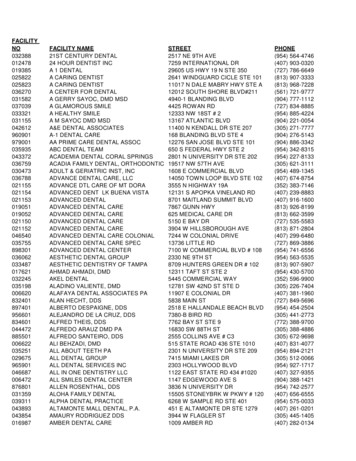
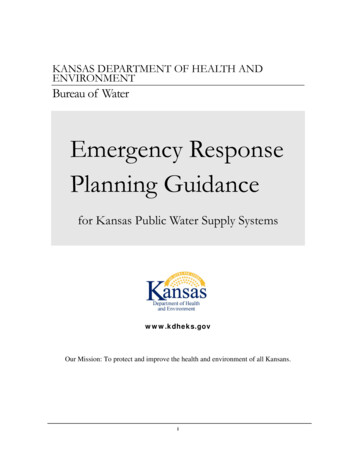



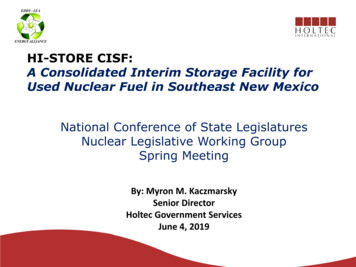
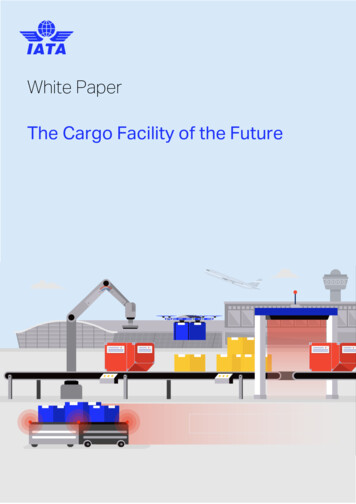

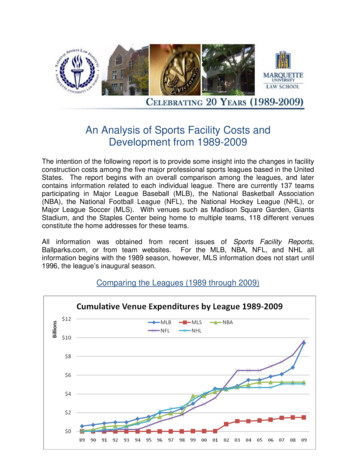
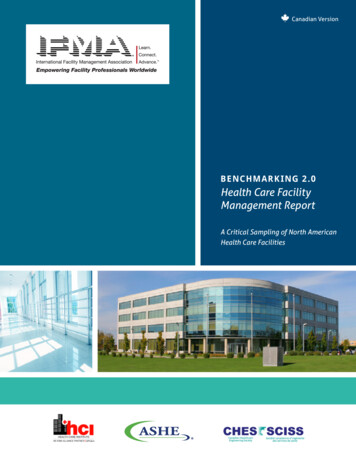
![[Facility Name] RESIDENT FOOD SURVEY](/img/4/resident-food-survey-template.jpg)
